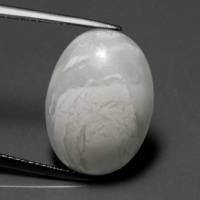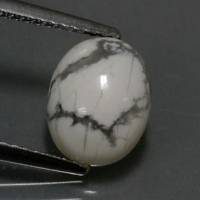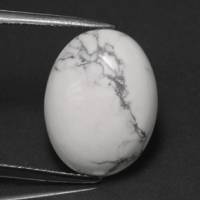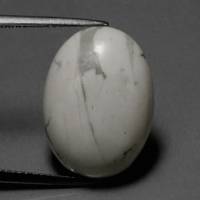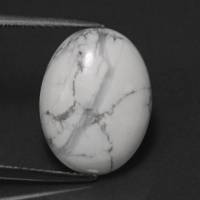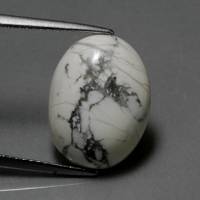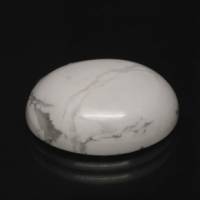Howlite

USA
9.98 carats
© gemselect.com
It often forms in nodules which resemble cauliflower heads. The nodules are opaque, white with gray or black veins, often showing web-like pattern. Crystals are very rare and are found in only a couple localities in the world. The maximum size of crystals is about 1 cm.
Howlite is used for cabochons, decorative objects, beads, small carvings or jewelry components. Dyed blue howlite is used as a turquoise substitute and is sometimes marketed as turquenite.
Howlite Gemstones by Colour
This table shows the variety of hues this gemstone can be found in. Click on a photo for more information.
Howlite Gemstones by Size
This table shows distribution of Howlite gemstone sizes that are listed on this site. This can give a good indication as to the general availability of this gemstone in different sizes.
Contributed photos
Lightest:2.36 cts
Heaviest:33.94 cts
Average:9.99 cts
Total photos:22
Do you have a larger Howlite? Why not upload a photo?
| General Information | ||||||||||||||||||
|---|---|---|---|---|---|---|---|---|---|---|---|---|---|---|---|---|---|---|
| Chemical Formula |
| |||||||||||||||||
| Howlite Treatments | ||||||||||||||||||
| Howlite has been dyed various colors and may also be waxed. An elaborate carving was dyed blue to produce a superficial resemblance to turquoise; a test used to identify it was to etch the surface with acid and observe melting of the howlite with a hot needle (Crowningshield, 1969) – Nassau (1984) Dyed blue to imitate turquoise (and lapis lazuli). Acetone test may reveal the dye - Blue Chart Gem Identification, Herve Nicolas Lazzarelli, 2010, p 5 | ||||||||||||||||||
| Physical Properties of Howlite | ||||||||||||||||||
| Mohs Hardness | 3 to 3.5, Blue Chart Gem Identification (2010) More from other references | |||||||||||||||||
| Specific Gravity | 2.45 to 2.58, Blue Chart Gem Identification (2010) More from other references | |||||||||||||||||
| Cleavage Quality | None, Gemstones (2009) | |||||||||||||||||
| Fracture | Uneven, Gemstones (2009) | |||||||||||||||||
| Optical Properties of Howlite | ||||||||||||||||||
| Refractive Index | 1.583 to 1.608, Blue Chart Gem Identification (2010) More from other references | |||||||||||||||||
| Optical Character | Biaxial/-, Gemmological Tables (2004) More from other references | |||||||||||||||||
| Birefringence | 0.019, Gemmological Tables (2004) More from other references | |||||||||||||||||
| Pleochroism | Nil, Gemstones (2009) | |||||||||||||||||
| Dispersion | Nil, Gemstones (2009) | |||||||||||||||||
| Colour | ||||||||||||||||||
| Colour (General) | Natural color: white, commonly with gray to black "spiderweb" matrix., Blue Chart Gem Identification (2010) More from other references | |||||||||||||||||
| Colour (Chelsea Filter) | Dyed howlite: pink to red, Blue Chart Gem Identification (2010) | |||||||||||||||||
| Causes of Colour | Blue, dyes exclusively, Pragmatic Spectroscopy For Gemologists (2011) | |||||||||||||||||
| Transparency | Opaque, Gemmological Tables (2004) More from other references | |||||||||||||||||
| Lustre | Vitreous,Dull (Earthy), Gemstones (2009) sub-vitreous | |||||||||||||||||
| Fluorescence & other light emissions | ||||||||||||||||||
| Fluorescence (Short Wave UV) | Occasionally orange, Gemmological Tables (2004) More from other references | |||||||||||||||||
| Fluorescence (Long-Wave UV) | Brownish-yellow, Gemmological Tables (2004) More from other references | |||||||||||||||||
| Crystallography of Howlite | ||||||||||||||||||
| Crystal System | Monoclinic, Blue Chart Gem Identification (2010) More from other references | |||||||||||||||||
| Habit | Tabular, Gems, Sixth Edition (2006) More from other references | |||||||||||||||||
| Geological Environment | ||||||||||||||||||
| Where found: | Howlite is found in borate deposits., Gems, Sixth Edition (2006) | |||||||||||||||||
| Further Information | ||||||||||||||||||
| Mineral information: | Howlite information at mindat.org | |||||||||||||||||


